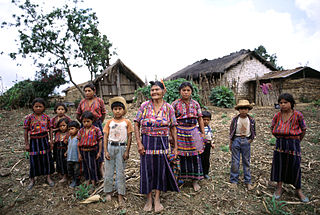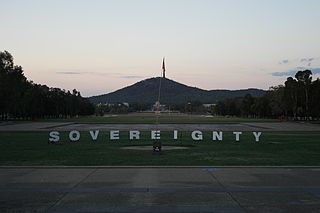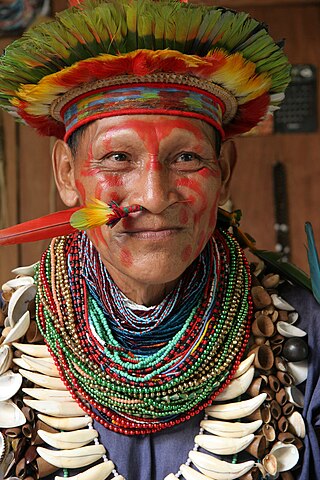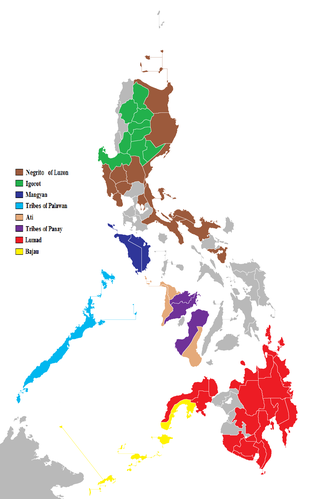History
The term was used as early as the 1920s in the work of the International Labour Organization (ILO). [7]
Initially, the ILO was concerned with the situation of indigenous and tribal peoples in their roles as workers in the overseas colonies of European powers. It became increasingly evident that indigenous peoples were exposed to severe labour exploitation and had a need for special protection in cases where they were expelled from their ancestral domains only to become seasonal, migrant, bonded or home-based labourers. This recognition led to adoption in 1930 of the ILO's Forced Labour Convention (No. 29). [7]
Following the creation of the United Nations, the ILO with the participation of other parts of the UN system created the Indigenous and Tribal Populations Convention (No. 107). Convention No. 107 was adopted in 1957 as the first international treaty on this subject. [7]
This involved the underlying assumption that the only possible future for indigenous and tribal peoples was integration into larger society, and that the state should make decisions regarding indigenous development. In 1986 an ILO committee of experts concluded that "the integrationist approach of the Convention was obsolete and that its application was detrimental in the modern world." [7]
In 1988 and 1989, the revision of Convention No. 107 was on the agenda of the International Labour Conference (ILC) and in June 1989, the Indigenous and Tribal Peoples Convention (No. 169) was adopted. [7]
This paved the way for the United Nations Declaration on the Rights of Indigenous Peoples in 2007.
Regional contexts
Indonesia
In 2013, the Indonesian Constitutional Court amended the 1999 Law on Forestry to return land rights to indigenous peoples whose ancestral lands are forested. [11] [12]
In Indonesia, there have been many land conflicts regarding indigenous community territories in resource-rich Kalimantan. According to data quoted in the Jakarta Post , following the enactment of the Masterplan for the Acceleration and Expansion of Indonesian Economic Development (MP3EI) in 2011, some 135 communities became involved in conflict with businesses. [13] Many conflicts involve indigenous peoples' traditional cultures being uprooted by palm oil plantations, or logging or mining interests.
NGOs in Indonesia set up the Ancestral Domain Registration Agency. A community mapper said the agency was created to "be prepared for the court ruling. If it the Constitutional Court ruled that customary forests belonged to indigenous peoples, we wanted to be able to show where those customary forests were located." [13]
Canada
The common term in Canada is "traditional territory". This can refer the entire homeland of a large ethnic group or the particular hunting and trapping grounds of a small band society. In areas where treaties have been signed, it refers to the land outside of Indian reserves in which a particular indigenous nation still claims an interest. In the case of specific rights to hunt and fish in a territory, these are called "aboriginal rights" and are a separate legal category from "treaty rights". In the case of areas where there are no treaties, such as most of British Columbia, the Supreme Court of Canada has ruled that aboriginal title applies to the entirety of a nation's claimed homeland, and not just to the particular locations of villages and other intensely-used sites. This was a unanimous ruling by the court in the 2017 case Tsilhqot'in Nation v British Columbia . However, in that same year, the Canadian court rejected the spiritual use of a site as being sufficient to establish aboriginal title, in Ktunaxa Nation v British Columbia (Forests, Lands and Natural Resource Operations) .
Philippines
In the Philippines, the term is used to refer to indigenous peoples' land rights in law. [14] Ancestral lands are referred to in the Philippines Constitution. Article XII, Section 5 says: "The State, subject to the provisions of this Constitution and national development policies and programs, shall protect the rights of indigenous cultural communities to their ancestral lands to ensure their economic, social, and cultural well-being." [15]
The Indigenous People's Rights Act of 1997 recognizes the right of Indigenous peoples to manage their ancestral domains. [16] The law defines ancestral domain to include lands, inland waters, coastal areas, and natural resources owned or occupied by Indigenous peoples, by themselves or through their ancestors. [17]
The Food and Agriculture Organization's research on forest land ownership in the Philippines found conflicts in institutional mandates among the Local Government Code, mining law and the National Integrated Protected Areas Act, and recommended exclusive resource use rights to community-based forest management communities. [18]

There is no generally accepted definition of Indigenous peoples, although in the 21st century the focus has been on self-identification, cultural difference from other groups in a state, a special relationship with their traditional territory, and an experience of subjugation and discrimination under a dominant cultural model.

Australian Indigenous sovereignty, also recently termed Blak sovereignty, encompasses the various rights claimed by Aboriginal and Torres Strait Islander peoples within Australia. Such rights are said to derive from Indigenous peoples' occupation and ownership of Australia prior to colonisation and through their continuing spiritual connection to land. Indigenous sovereignty is not recognised in the Australian Constitution or under Australian law.

The Lumad are a group of Austronesian indigenous peoples in the southern Philippines. It is a Cebuano term meaning "native" or "indigenous". The term is short for Katawhang Lumad, the autonym officially adopted by the delegates of the Lumad Mindanao Peoples Federation (LMPF) founding assembly on 26 June 1986 at the Guadalupe Formation Center, Balindog, Kidapawan, Cotabato, Philippines. Usage of the term was accepted in Philippine jurisprudence when President Corazon Aquino signed into law Republic Act 6734, where the word was used in Art. XIII sec. 8(2) to distinguish Lumad ethnic communities from the islands of Mindanao.
Indigenous land rights are the rights of Indigenous peoples to land and natural resources therein, either individually or collectively, mostly in colonised countries. Land and resource-related rights are of fundamental importance to Indigenous peoples for a range of reasons, including: the religious significance of the land, self-determination, identity, and economic factors. Land is a major economic asset, and in some Indigenous societies, using natural resources of land and sea form the basis of their household economy, so the demand for ownership derives from the need to ensure their access to these resources. Land can also be an important instrument of inheritance or a symbol of social status. In many Indigenous societies, such as among the many Aboriginal Australian peoples, the land is an essential part of their spirituality and belief systems.
Traditional knowledge (TK), indigenous knowledge (IK), folk knowledge, and local knowledge generally refer to knowledge systems embedded in the cultural traditions of regional, indigenous, or local communities.

Indigenous and Tribal Populations Convention, 1957 is an International Labour Organization Convention within the United Nations that was established in 1957. Its primary focus is to recognize and protect the cultural, religious, civil and social rights of indigenous and tribal populations within an independent country, and to provide a standard framework for addressing the economic issues that many of these groups face.
The Indigenous and Tribal Peoples Convention, 1989 is an International Labour Organization Convention, also known as ILO Convention 169, or C169. It is the major binding international convention concerning indigenous peoples and tribal peoples, and a forerunner of the Declaration on the Rights of Indigenous Peoples.
Human rights in the Philippines are protected by the Constitution of the Philippines, to make sure that people in the Philippines are able to live peacefully and with dignity, safe from the abuse of any individuals or institutions, including the state.

Indigenous intellectual property is a term used in national and international forums to describe intellectual property that is "collectively owned" by various Indigenous peoples, and by extension, their legal rights to protect specific such property. This property includes cultural knowledge of their groups and many aspects of their cultural heritage and knowledge, including that held in oral history. In Australia, the term Indigenous cultural and intellectual property, abbreviated as ICIP, is commonly used.
In Australia, Canada, New Zealand and the United States the term treaty rights specifically refers to rights for indigenous peoples enumerated in treaties with settler societies that arose from European colonization.
Indigenous rights are those rights that exist in recognition of the specific condition of the Indigenous peoples. This includes not only the most basic human rights of physical survival and integrity, but also the rights over their land, language, religion, and other elements of cultural heritage that are a part of their existence and identity as a people. This can be used as an expression for advocacy of social organizations, or form a part of the national law in establishing the relation between a government and the right of self-determination among its Indigenous people, or in international law as a protection against violation of Indigenous rights by actions of governments or groups of private interests.

The Indigenous peoples of the Philippines are ethnolinguistic groups or subgroups that maintain partial isolation or independence throughout the colonial era, and have retained much of their traditional pre-colonial culture and practices.
Pan-Indianism is a philosophical and political approach promoting unity, and to some extent cultural homogenization, among different Indigenous groups in the Americas regardless of tribal distinctions and cultural differences.
Counter-mapping is creating maps that challenge "dominant power structures, to further seemingly progressive goals". Counter-mapping is used in multiple disciplines to reclaim colonized territory. Counter-maps are prolific in indigenous cultures, "counter-mapping may reify, reinforce, and extend settler boundaries even as it seeks to challenge dominant mapping practices; and still, counter-mapping may simultaneously create conditions of possibility for decolonial ways of representing space and place." The term came into use in the United States when Nancy Peluso used it in 1995 to describe the commissioning of maps by forest users in Kalimantan, Indonesia, to contest government maps of forest areas that undermined indigenous interests. The resultant counter-hegemonic maps strengthen forest users' resource claims. There are numerous expressions closely related to counter-mapping: ethnocartography, alternative cartography, mapping-back, counter-hegemonic mapping, deep mapping and public participatory mapping. Moreover, the terms: critical cartography, subversive cartography, bio-regional mapping, and remapping are sometimes used interchangeably with counter-mapping, but in practice encompass much more.
Indigenous land rights in Australia, also known as Aboriginal land rights in Australia, are the rights and interests in land of Aboriginal and Torres Strait Islander people in Australia; the term may also include the struggle for those rights. Connection to the land and waters is vital in Australian Aboriginal culture and to that of Torres Strait Islander people, and there has been a long battle to gain legal and moral recognition of ownership of the lands and waters occupied by the many peoples prior to colonisation of Australia starting in 1788, and the annexation of the Torres Strait Islands by the colony of Queensland in the 1870s.
The lands inhabited by indigenous peoples receive different treatments around the world. Many countries have specific legislation, definitions, nomenclature, objectives, etc., for such lands. To protect indigenous land rights, special rules are sometimes created to protect the areas they live in. In other cases, governments establish "reserves" with the intention of segregation. Some indigenous peoples live in places where their right to land is not recognised, or not effectively protected.
The Sagong Tasi case was a landmark land rights case in Malaysia, in which the courts ruled against the Selangor State in favour of the Temuan-Orang Asli plaintiffs.

The Indigenous Peoples' Rights Act of 1997 (IPRA), officially designated as Republic Act No. 8371, is a Philippine law that recognizes and promotes the rights of indigenous cultural communities and Indigenous peoples in the Philippines.
Free, prior and informed consent (FPIC) is aimed to establish bottom-up participation and consultation of an indigenous population prior to the beginning of development on ancestral land or using resources in an indigenous population's territory. Indigenous people have a special connection to their land and resources and inhabit one fifth of the Earth's surface. Such areas are environmentally rich in both renewable and non-renewable resources. The collective ownership style of most Indigenous Peoples conflicts with the modern global market and its continuous need for resources and land. To protect Indigenous Peoples' rights, international human rights law has created processes and standards to safeguard their way of life and to encourage participation in the decision-making process. One such method is the process of FPIC. There is criticism that many international conventions and treaties require consultation, not consent, which is a much higher threshold. Without the requirement for consent, indigenous people cannot veto government projects and developments in their area that directly affect their lives and cultures. FPIC allows Indigenous Peoples to have the right to self-determination and self-governance in national and local government decision-making processes over projects that concern their lives and resources.
Robyn Ann Layton is an Australian lawyer, who worked in a diverse range of legal roles, including as a judge of the Supreme Court of South Australia and judge of the South Australian Industrial Court. She was author of the South Australian Child Protection review known as "the Layton report" in 2003, and a member and then chair of the International Labour Organization's Committee of Experts on the Application of Conventions and Recommendations from 1993 to 2008.






